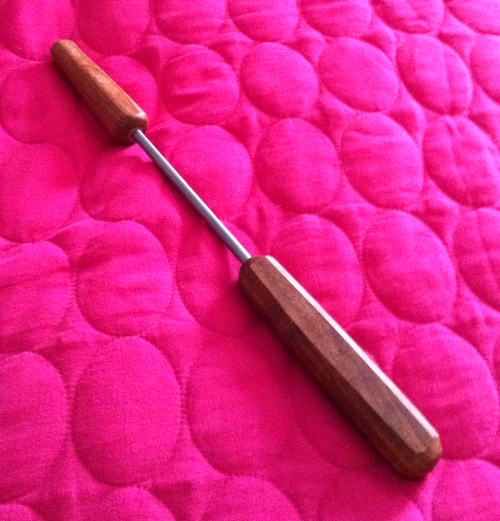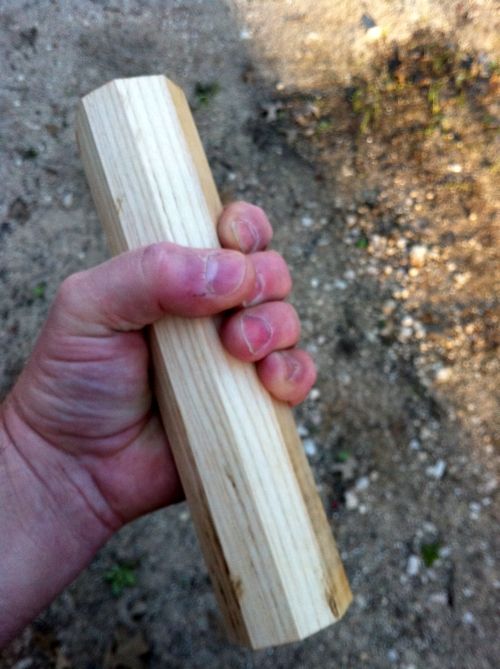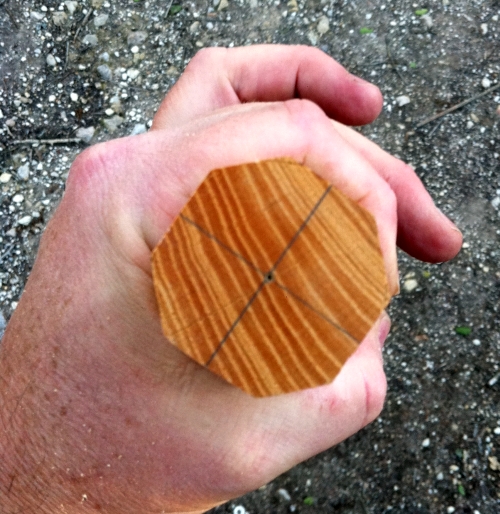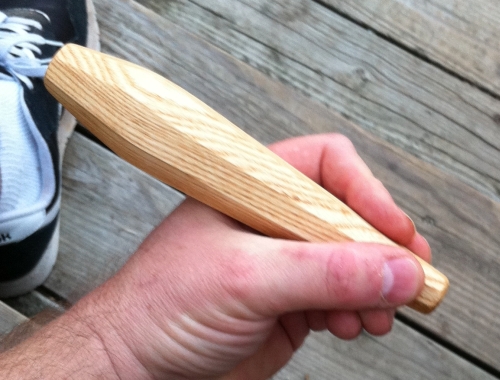The previous discussion of grips is far from over!
One method I have used to compare grips, is to have them face off. Then I can see, as I swap hands and grips, which grip applies more force with less effort.
I followed the suggestions of a source that advised making an OK sign with your thumb and index finger to find the ideal diameter for a tool.
I think I will ignore that source from here on out, the handle is way too big. 1 3/4″ is definitely too large. My smaller fingers only get a bit more than half way around this. Not a secure grip.
So now I will evaluate another source of ergonomic data.
The study, Optimal cylindrical handle diameter for grip force tasks
by Yong-Ku Kong and Brian D. Lowe, indicates that an ideal diameter would be 19.7% of the distance from the tip of the middle finger to the crease where the wrist starts and the palm ends. If I divide this by pi, to get a diameter I get 6.27%. From middle finger tip to crease, I measure right at 8″. From their data, a 1/2″ diameter grip would be ideal for me. OK, we are back to the drawing board. I like 1/2″ for a pen, but it is way to small for a good chisel grip.
So after loosing faith in authoritative experimental data in this field, it is time to use simple logic. If the grip spreads the forces to a maximum area of the hand, this will reduce stress. If it can be spread evenly or distributed to use the strengths of the hand well, that will be even better. Having the handle function for a wide range of grips is also a must. It also seems logical that a larger grip will reduce the chance of cramping by keeping fingers less tightly curled.
Another question for me is whether an octagon puts more stress on due to micro-adjustment or less stress due to positional feedback. since the bones swivel all the way back from the elbow, I suspect that micro-adjustment is no big issue. So my guess is that the solidity of the grip and the feedback makes the octagon superior. On the other side, I have used a hexagon shaped tool handle and found the facets to be much too large. is reducing the facets from six to eight enough?
In any case I am forced to examine my hand and the grips I use and the size of handle that that grip requires.
When pounding on a chisel I use a hammer grip with the blade pointing down. Slightly over 1″ feels about right.
I want to start using the gouge grip,

But I don’t want the butt of the chisel in my palm since industrial statistics show a good deal of hand injuries are related to tools that are pushed by the palm.
When chiseling away from me I usually use a fencing grip with my index finger extended towards the blade. Again, a hair over 1″ feels pretty good.
When chiseling across relative to my body, I just grab the chisel. I may fold the thumb back if I need extra clearance. 1″ again is fine.
For detail I like to use several different pinch grips. For this, 1″ is usable but too large. I like a big pencil but if it gets too far over 1/2″ it stops being comfortable.
For cutting and whittling, my grip is pretty standard, with my thumb extended on the back of the blade. I am used to a fairly wide range of sizes for knives, so I don’t have a huge preference here.
To accommodate all of these grips, a handle that tapers from a bit larger than 1″ to about 1/2″ at the tip may be the solution. This profile seems to match with what Thomas Martin, in his, The Circle of the Mechanical Arts, London, 1813 considered a to be a chisel grip.

Since I like a fencing grip quite a bit, I want the tool to taper from a maximum diameter of about 1 1/8″ to a minimum diameter of maybe 1/2″ inch over the distance from the tip of my pointing finger on the tool, to where my pinkie wraps around the tool. I want my pinkie on the back side of a taper to give it a secure grip. After a bunch of figuring I came up with a 1 to 16 slope and made this cone.
I mostly used the methods shown by Timber Frame Tools. I figured out that if I cut a taper on the side of the V-Block, it would make a good guide for getting the angles correctly. Oddly enough this works the same even after you have cut down the tools other sides. The V-Block mounted on a board, can be both a guide for sawing, and a specialized shooting board for reproducing handles. 🙂
Then I gripped the cone to see if I even liked the thing and adjusted to where it felt snug in my hand.
The point between my pinkie and my ring finger, was where I decided to start my taper. I made a second cone so I could keep the first as a reference. The angle of the back taper was selected by feel. I kept pruning down until I liked the feel of it. The slope on the back is 1 to 4.
Then I smoothed it down. Cut off the excess on both ends and smoothed it some more. I am quite pleased with the book matched grain appearance!
The chisel is 7″ long, 1 1/4″ at the thickest and 5/8″ at the thinnest. Not quite the dimensions I was expecting, but I love this handle.
And it does it all!
Low Clearance grip for chiseling horizontally in front of you.
Regular grip for chiseling horizontally in front of you.
Fencing grip for chiseling away from your body.
Gouge Grip, which I have not used enough to know when to prefer it yet.
Mallet grip for when you are pounding a chisel. I will also put my other hand over the hand holding the tool, to add pressure while rocking the chisel side to side for deeper push cuts.
I don’t actually use this one, but I was taught to use it so that injuries would be less if I missed and hit my hand. I still think it will hurt pretty bad.
This is a grip that I use with a knife edge when whittling. I also use it for chiseling upward. When using a paring chisel, I usually use the fencing grip.
Then there are a couple of pinch grips that I use.
Keith Cruickshank’s amazing Video Blog has a video showing some carving grips by Brad Ramsay.
Brad has some amazing skills there!
After watching the video again, and getting some feedback on grips from WoodNet, It is possible that I have most of the single hand grips, but have left out the zillions of two handed variations.
Now that I have listed all the grips that I use, I would love to know if I am missing any important ones, or better ones?
Back to the octagonal grip in hand, I love it! It feels right! It is a lot of work to make right, and I fear that when I drill the end to put a bit on it, I will go crooked and make the tool look stupid after all this work. Still it is all worth it. Unless I hate it after I actually use it, this is now hands down and entirely, my favorite handle size and shape. Oddly enough, my better half loves it too, and she has tiny hands compared to me.
Bob














 A page Dedicated to My Writing
A page Dedicated to My Writing
Bob, that prototype looks great. That is no easy feat to end up with an octagon tapering in two directions and still ending up with flats that match each other so well. It is very easy to end up with a flat that is noticeably narrower or wider than the others.
I like the fact that the double tapers give you so many possible variations on grip.
I wish I had a tip for you on drilling a straight hole in the end of the handle. I don’t envy the attempt with the double tapers. Makes it hard to clamp plumb and securely. I might try drilling the blank before you do any tapering. Another option would be a really long drill bit (if using a hand drill) so that it will exaggerative being off plumb so you can spot it and fix it. I’ve made plenty of file handles that I thought I drilled straight only to end up a little crooked once pounded in to place, so I know what fears you are having there. Good luck.
-Steve
You are entirely right, Steve! I should have drilled it first. I will probably try to center it and drill it on my lathe. That may give me the best odds.
Now that I have done it, I have a reliable method of making these handles. It requires you to make three specialized shooting boards.
First make three V-Blocks reasonably longer than the handles you plan to make. Take the first one, flip it over and mark the center line. From the center line mark the maximum radius of the tool handle plus a bit more for evening up and sanding/scraping. Now cut off the side at that mark. If you mount this V-block with one side short, on a board, you can then put a nice square rod section in it, and slide a plane along the side, just like a shooting board. In short time you can take off the four corners off the square piece, and then shave the four original sides to match. If your V-Block is square and the rod was square, you should now have a nice hexagonal rod just a hair larger than you plan for the final handle to be.
Take the second V-Block, flip it over and mark the center line. Now mark the taper that you desire, and then saw on that line. My block has the taper from the center line to the outside of the block at a 1:16 slope. Then I have a bit more that still has the full V-Block at the end. With this mounted on a board, you can now plane down the sides. Even as you remove material and the tapered part of the handle drops lower into the V-Block, the alignment will remain. After planing down the sides of your hexagonal rod, you should now have a nice octagonal taper.
Now take the third V-Block. Using the same methods as before, cut the angle for the butt of the chisel. My chisel ended up with a 1:4 slope, so that is what my block has. Even though the tapered handle does not rest flat in the V-Block the area that projects past the tapered cut will still be the material that you want to remove!
After shaving the butt to shape, now smoothing the transitions, ends and edges is all that you have to do!
It should even be possible to alter the size of the tool handle by changing the position of the stop pin, or by inserting shims. I put a section of the V that was left after cutting the V-block at the end of my V blocks, for stops, instead of pins. I can easily use more sections of that V as shims to alter the size of the handle.
Bob
When I try the OK method, my first observation is the the opening between my thumb and forefinger is more of a rectangle than a circle. Should one use the major or minor diameter? Perhaps an oval or elongated octagon would be better. I think using the major diameter for a circular cross-section handle would be too large. Another consideration would be the desirability of directionality in the cross-section to the way the tool is used.
How the handle is loaded has to be considered as well. Does it need to twist? If so in what axis? Is it loaded axially? In what direction? Towards you or away from you? Is it loaded laterally? Fore and Aft, side to side, or up and down? Any combination of the above?
Also, I’m not sure you are using the wrist crease to tip of middle finger method correctly. You describe the method as recommending 19.7% of the distance as the ideal DIAMETER. Why divide a diameter by PI to get another diameter? A 1.58″ diameter seems a lot more reasonable than 1/2″.
In general relating handle dimensions to hand size seems appropriate, but I suspect any ratios so derived should be specific to the loading, orientation, and required motion of the tool.
Andrew Adams
I have dropped the math, hands are disproportional. I now go with a hexagonal cone. I slide my hand to the largest point where it is comfortable, And the line where between my pinky and ring finger is where the back taper begins. So far that has worked out really well.
Bob